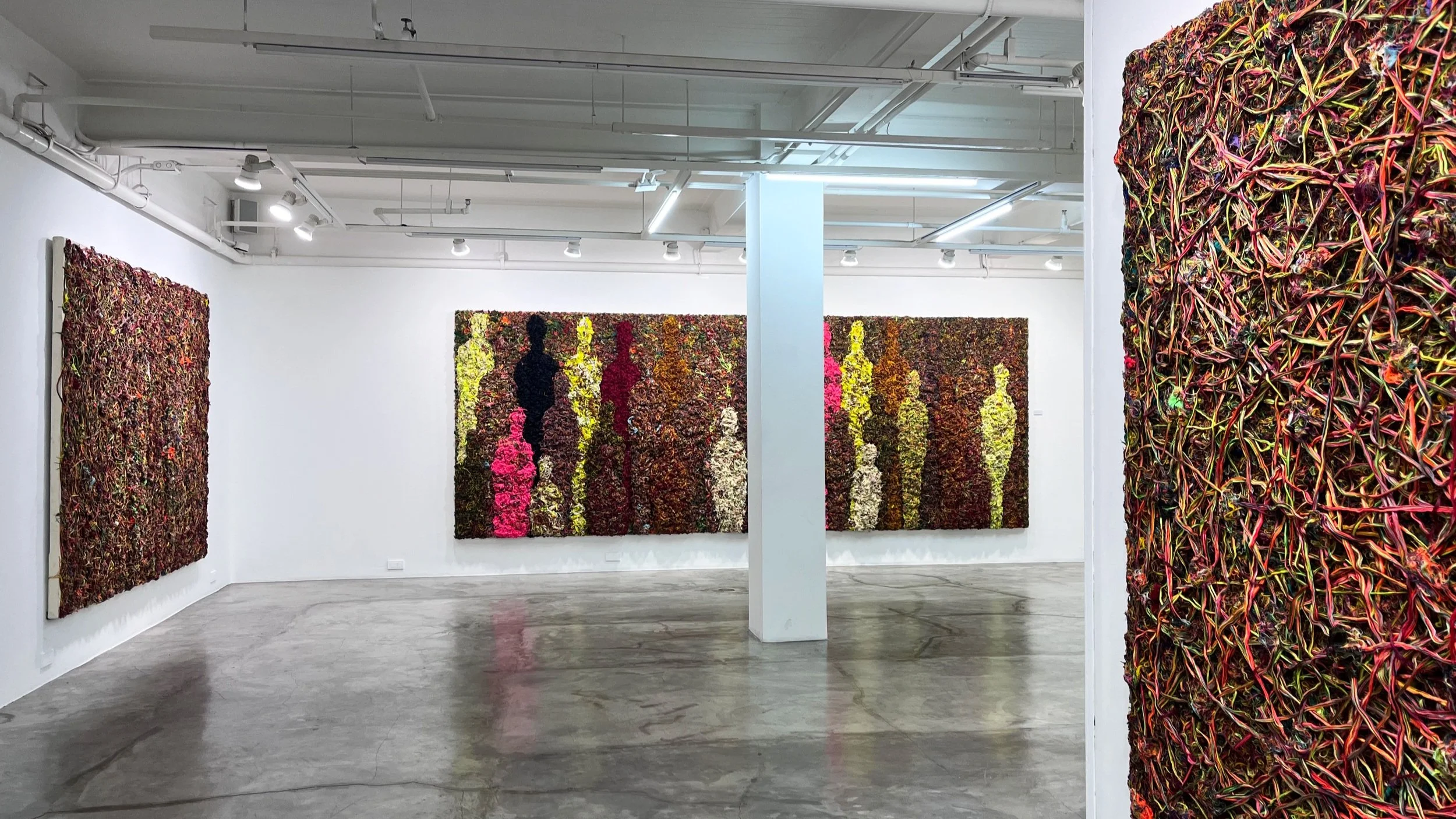To Fray a Canvas From Center to Seam
Raffy T. Napay salvages the threadbare in Mugmog
Written by Chesca Santiago
November 15, 2023
Raffy T. Napay’s vibrant thread on canvas works stand out against West Gallery’s white, brightly-lit space
Raffy T. Napay’s practice with thread comes from an intimate familiarity with its process and parlance—a command demonstrated by his ingenuity with the medium through the years. Previously, in his 2022 solo exhibition at West Gallery, thread figured as sewn material on canvas and as a component for installations. Mugmog, his most recent solo show at the same gallery, marks another turn in modus operandi. The needle barely figures this time; instead of sewing, Napay’s chosen schemes for the thread are clumping, coiling, and sticking. Tangled clumps of string glued onto large-scale canvases that each occupy their own wall in the space.
The exhibition takes off and borrows its name from Filipino sewing vernacular: mugmog—scrap thread or fabric salvaged to become fillings for rugs. They come from textile cuttings, perhaps from the frayed edges or the excess inches snipped off a piece of cloth, bundled together into plastic bags and sold for roughly 10 pesos per kilogram. Rescued from the waste pile, it is thanks to the mugmog that the seamstress gets their material for a trusty floor mat or for a basahang bilog.
Bukas (2023) plays with depth and color by layering colored thread atop plain white strings.
It is apparent that Napay is translating this exercise of extending lifespans and lifeforms onto the canvas. He makes no mention about the source of his materials for this show (i.e. whether they are actually scraps as in mugmog); but the likeness remains uncanny. By shying away from the needle and refusing to sew his materials, the ends of the thread are kept out in the open. What emerges is a general sense of disarray: his canvases are how one would see mugmog bundled inside a plastic bag or littered across the floor of a patahian. Coiled, knotted, tattered, and snaking towards all directions. Canvases frayed in their entirety, not just at the seams.
Details of Tayo (2023), where frayed ends of threads are made most apparent.
And yet they thrive in this jumble. Even from afar, one understands that Napay’s ploy is one of orchestrated clutter, for it is through this mayhem of thread that he executes his intentions. Clustering the thread in thick masses, Napay toys with color, length, and orientation to hint at his figurations. It is how we could make out silhouettes despite these motley tangles. At times, he picks color as his device. This is most evident in his longest canvas for the show: the 6 x 16 feet Tayo (2023), where over a dozen silhouettes of men—shadows, if one may—emerge in solid yellows, pinks, blacks, and reds against the colorful clumps that make their backdrop. With white as its background, a similar scheme is applied for Binubuo (2023).
Binubuo (2023) toys with contrasts in thread color.
In other instances, the instrument is depth. Bukas (2023) traces a silhouette by layering colored threads atop plain white strings that form the base layer of the work. Other times the scheme is more subtle. In Pakiramdam (2023), Napay juxtaposes threads of the slightest difference in tone to faintly reveal an outline. In the same artwork, he plays with orientation, laying out red thread in lines that spread out radially from the center—the heart—of the figure. The same is performed in Pinanggalingan (2023). The canvas is largely constituted by thread strung together in straight, angular lines. But one makes out the slightest profile of a man formed by clusters of coiled thread in the center.
Through thread, Pakiramdam (2023) traces how it is to feel.
Tangled, matted, intertwined—Napay’s operation centers on bonds and attachments. Taking the artworks’ titles and figurations as cue, there is an implicit reckoning of being. No one lives through isolation and disconnect; for our existence is one constituted by lines that entwine ourselves in a complex web with others. On its own, a single scrap of thread and fabric would be deemed too trivial for use. They would be rendered waste, ready to be discarded. But like the mugmog that garners value in multitude, the thread in Napay’s canvases find essence only in connection. In a web that entangles our relations, feelings, and tomorrows with one another.





